|
NATIONAL PARK SERVICE
Great Lakes Shoreline Recreation Area Survey |

|
REMAINING OPPORTUNITIES IN NEW YORK
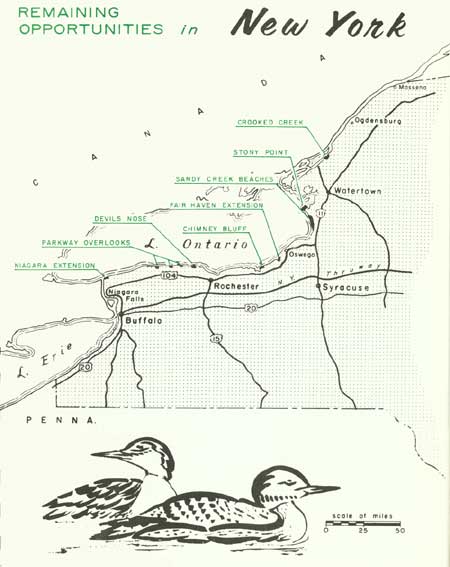
|
| Remaining Opportunities in New York (Vicinity Map) (click on image for an enlargement in a new window) |
SUMMARY
The cold, blue waters of the St. Lawrence River, draining the entire basin of the Great Lakes, are currently the scene of a great seaway development program--a program destined to bring increased material wealth and population growth to New York State's second seacoast. Such cities as Buffalo, Rochester, Oswego, Ogdensburg and Massena cannot help but benefit from such a program. With this new industrial impetus will come an acceleration of related construction activities: new homes, shops, schools and churches. Also needed will be additional highways and park areas to insure that the increasing population will always have access to the benefits and aesthetic values offered along the shoreline. This applies not only to the St. Lawrence River but to the Great Lakes as well.
The extensive St. Lawrence State Park will be established on lands created by the Seaway, and New York now has 23 other state parks located along the 775 miles of shoreline covered by this report. However, lest this picture be misleading, it should be stated that 12 of these are closely grouped in the Watertown-Thousand Island Area, and six others are closely clustered along the Niagara River, leaving only five parks scattered over the remaining shoreline. With more and more people flocking to the shores every year, there is no denying the need for expansion.
To many people, the Thousand Islands and the St. Lawrence are synonymous. The island-studded river and surrounding country have long been a tourist mecca; and most of the islands, even the most ludicrously small, are occupied by private homes ranging from modest summer cottages to palatial mansions. This "granite knob" country is of great geologic interest, for here the ancient Pre-Cambrian rocks linking the Adirondacks to the Laurentian Highlands are exposed.
A large mainland study area and island have been designated by the Survey on the St. Lawrence--not through any lack of existing parks, but because the preservation of a major natural area is particularly desirable in this region. The mainland portion offers excellent opportunities for preserving natural biological and geological attributes of the St. Lawrence scene. The island has wildlife value as a rookery for great blue herons.
Nearly half of New York's mainland frontage on the Great Lakes system is on Lake Ontario. From the St. Lawrence River, this shore extends westerly and southerly for 294 miles to Fort Niagara at the mouth of the Niagara River. For the purpose of convenience, it might be best to think of the shore in terms of three segments: from the St. Lawrence River to Pulaski, from Pulaski to Rochester, and from Rochester to Fort Niagara.
The St. Lawrence to Pulaski region can be broken down a second time into a northern section of low lying limestone headlands, bays, peninsulas and islands; and the sandy beaches and marshes south of Stony Point. For retention of natural values, this segment of shore is the best on Lake Ontario. Two study areas occur here: one in the limestone areas at Stony Point and one in the sand beach and marsh portion referred to as Sandy Creek Beaches.
The Pulaski-Rochester region lies along the northern edge of the largest drumlin field in the United States. These curious, glacier-moulded hills lie on a north-south axis. Along Lake Ontario, particularly east of Oswego, the waves of the lake have truncated these hills, leaving a series of high shore bluffs alternating with bays, streams, ponds or marshes. The two study areas of this portion of shoreline both contain drumlins. One is a recommended extension of Fair Haven State Park. The second area is a wave-eroded drumlin with high scenic values and geologic interest.
Except for a few drumlins around Braddock Bay, the region from Rochester to Fort Niagara is characterized by post-glacier lakebed topography. The land, rising gently back from the lake, is affected by the moderating influence of the lake on the region's climate. Consequently, this is one of the great orchard regions of the eastern United States. It is a pleasant country of prosperous looking farmland, orchards and woodlots. The lake shore, however, is backed by shore bluffs, and beaches are narrow and largely of cobble. The three study areas of this section are all tied in with the projected extension of the Lake Ontario State Parkway; two are extensions of existing state parks, and the third provides for scenic overlooks along the Parkway at strategic intervals.
The Niagara River, with its world famous falls, has no study areas designated because of ample coverage in the existing state parks. The 77 miles of Lake Erie shoreline in New York have already been developed to such an extent as to nearly preclude further possibilities. Two state parks already exist along this shore.
On Lakes Erie and Ontario, New York has but slightly over 11 miles (less than two percent) of mainland shoreline in state parks. The total water frontage of the various island and mainland parks on the Niagara and St. Lawrence Rivers raises the total to 50 miles. In this report, eight study areas with 28.4 miles of shoreline and 11,400 acres of land are recommended for further study as inclusions within the state park system. This would give the state a total of 78.4 miles of the over-all 775 miles of shoreline. Yet this would amount to only slightly over 10 percent, still far short of the 15 percent considered optimum to satisfy public recreation needs.
| NEW YORK |
NIAGARA EXTENSION
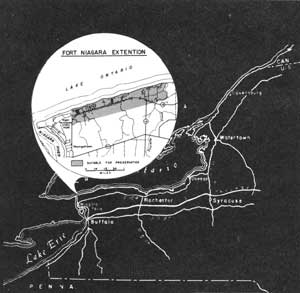
LOCATION The study area lies on Lake Ontario in the extreme northwest corner of Niagara County, New York. It extends along the shoreline for 2.3 miles from the present Fort Niagara State Park to the mouth of Fourmile Creek. Niagara Falls is just over 12 miles away and Buffalo and Rochester are about 35 and 85 miles distant, respectively. State Routes 18 and 18F traverse the study area and define its southern boundary.
DESCRIPTION The 648 acres of proposed extension comprise a linear area, about 1,000 feet deep, along the shore of Lake Ontario. The beaches fronting this 2.3-mile stretch range from narrow to practically nonexistent and are composed of sand, cobble and clay derived from the eroding shore bluffs behind them. In spite of attempts to control it through concrete groin construction, active erosion on these 20 to 30-foot bluffs has proceeded to the point where some structures near the edge are in danger of being under cut.
The nearly level land behind these bluffs is broken at two places by the outlets of Fourmile Creek and a smaller creek about one mile to the west. Fourmile Creek widens to about 200 feet near its mouth but is constricted there by a sand bar typical to streams in this vicinity.
PRESENT USE Within the bounds of the study area there are approximately 100 summer cottages and permanent homes, a few of which are of fairly substantial quality. These are primarily clustered into four groups separated by orchards and farmland. A fairly extensive amusement park occupies about 20 acres at the west end of the study area just outside the existing boundary of Fort Niagara State Park.
ANALYSIS As a result of increased power output from Niagara operations, industry is spreading north along the Niagara River and investigating expansion possibilities along the Lake Ontario shoreline. Fort Niagara State Park, presently squeezed into a small triangular area at the mouth of the river, needs additional space.
The area encompassed in this report would serve as a buffer against the impending industrial expansion. Although its natural values are limited, additional lakeshore frontage is also badly needed. Careful landscaping could restore the natural appeal, and a swimming beach could be created by sloping the bluffs and effectively utilizing erosion control measures to create sand fill.

|
| Niagara Extension |
| NEW YORK |
PARKWAY OVERLOOKS
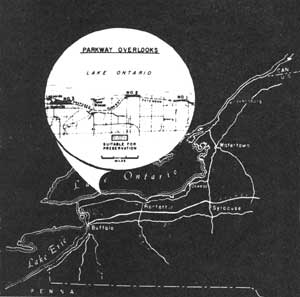
LOCATION The three study areas are all located in Orleans County in the path of the proposed westward extension of the Lake Ontario State Parkway. They lie along a 16-mile stretch of shoreline between Lakeside and Kendall. Number One is 3 miles north of Kendall; Number Two is adjacent to and west of Transit Road, roughly 4 miles north of State Route 18; and Number Three is paralleled by State Route 18 east of Lakeside. In aggregate they contain 821 acres of land and 4 miles of shoreline.
DESCRIPTION The region of Orleans County in which the Parkway Overlooks are located is former lakebed topography. The land has little relief except along stream courses. The three Overlooks have been largely cleared of their original forest cover, as, indeed, has most of the surrounding land. Only Number Three has any forest cover, the remaining timber being mainly beech, maple, elm, hophornbeam and ash.
Like much of southern Lake Ontario, the shoreline along the Parkway Overlooks is being gradually eaten away by the relentless action of the waves. Consequently, shore bluffs are a common feature. Overlooks One and Two are fronted by 10-foot bluffs, while Number Three has bluffs to 40 feet high. The beaches below these bluffs are narrow and formed primarily of cobble. The lake bottom along the shore is rocky and during May of 1958 was covered by unsightly growth of green algae.
During the spring, thousands of migrating Canada geese and gulls are an attraction along this portion of Lake Ontario.
PRESENT USE The three sites are given over almost entirely to farmlands. Number One has two farmhouses with attendant outbuildings. Number Two has four cottages, and Number Three has no structures. Bathing is not a feature along the shore because of the narrow cobble beach.
ANALYSIS Routing the Parkway through these Overlooks offers the motorist sweeping scenic vistas of the lakeshore and Lake Ontario with its ships and water birds. Thus variety is added to the inland sections of right of way where views may be restricted by the flat topography and adjacent developments. Only Overlook Number Three would be developed for such active uses as picnicking, swimming and camping.

|
| Parkway Overlooks |
| NEW YORK |
DEVILS NOSE

LOCATION Devils Nose lies between Troutburg and Hamlin Beach State Park at the present western terminus of the Lake Ontario State Parkway. This area would add 1.5 miles of shoreline to Hamlin Beach State Park. There are approximately 190 acres in the proposed addition.
DESCRIPTION Devils Nose receives its name from a 75-foot high bluff projecting out slightly into Lake Ontario. The bluff is primarily of sand but rests on a resistant projection of conglomerate just above the water line. Most of the gently undulating topography atop the bluff has been cleared and is occupied by about 65 acres of orchard. Two woodlots remain near the shore of the lake, aggregating 20 acres. Though they are small, the woodlots are attractive additions to the study area.
Fronting a shallow shoreline indentation east of Devils Nose is a sand beach. It is approximately a half mile long and is from 75 to 100 feet wide. This beach is significant because it occurs along a stretch of shoreline generally devoid of bathing beaches and would be a significant addition to Hamlin Beach State Park.
Backing the beach is a steep, sandy bluff averaging 40 feet in height. Along the top of the bluffs, large colonies of bank swallows have excavated their nesting holes. At the time of field investigations in late May, a constant stream of gulls were moving west along the shore, making use of the updrafts along the shore bluffs. In April, large flocks of Canada geese were observed near the shore along this same general region.
PRESENT USE Nine cottages are grouped at the east end of the beach. Orchards occupy about a fourth of the area. The remainder of the land, except the woodlots, is cleared but fallow.
ANALYSIS This area is needed as an extension of the Hamlin Beach State Park. The Lake Ontario State Parkway will eventually be constructed through the area. Scenic lake views, picnic areas and day use of the beach would be the important features of the area.

|
| Devils Nose |
| NEW YORK |
CHIMNEY BLUFF

LOCATION The study area is located 8 miles from Wolcott off U.S. Highway 104 on the road leading to East Bay Park. The total shoreline included in the study area is 1.3 miles. The bluff itself fronts on the lake for 1/2 mile. Approximately 150 acres comprise the study area.
DESCRIPTION Like Sitts Bluff in the Fair Haven Extension study area, Chimney Bluff is a wave truncated drumlin. The resultant erosion is the most spectacular on Lake Ontario. The rim of the bluff stands 130 feet above the water and extends inland 500 feet from the shore in a series of knife-edged ridges and chimneys. From the beach and from trails along the rim, scenic views of the bluff, the surrounding terrain and Lake Ontario may be obtained. Because the drumlin is exposed in cross section, it is valuable to geologists in studying the manner in which these interesting glacial deposits were formed.
The land contained within the study area is covered with an attractive and vigorously growing hemlock-hardwood forest. Large maple, ash, elm and hemlock shade an open understory containing a large variety of interesting forest floor species. Along the rim, hophornbeam is a common tree, and eastern columbine is a common spring flower.
The area is not large and could not be expected to support any but the smaller and commoner species of birds and wildlife. However, along the bluff, a large colony of bank swallows has excavated their nesting holes in the safety of the nearly perpendicular banks. During the summer months, their coming and going animates the natural scene.
PRESENT USE The only structure in the main area is a tavern; however, in the shore extension to the east are one or two houses. Some timber cutting is occasionally done, but the area probably receives practically no use except informal sightseeing.
ANALYSIS First of all, the area's primary value lies in the scenic qualities of the strangely eroded drumlin. Preservation of these features is important. The small size of the area suggests county or local administration which can supply day-use provisions for picnicking, and trails above and below the bluff for hikers. A low lying area extending along the east boundary might possibly be developed for beach use, thus adding to the area's drawing power.

|
| Chimney Bluff |
| NEW YORK |
FAIR HAVEN EXTENSION
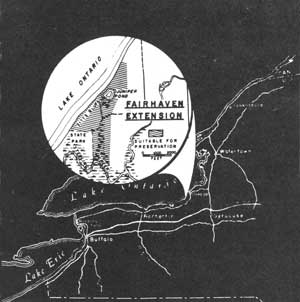
LOCATION The area lies adjacent to Fair Haven Beach State Park near the village of Fair Haven in Cayuga County. It can be reached by McIntyre Road via Sterling Center and Old State Roads from Fair Haven. The Extension would add 1-1/2 miles of shoreline and 386 acres to the state park.
DESCRIPTION Between Oswego and Rochester lies a portion of the largest drumlin field in the United States. The landscape is distinctive, particularly along Lake Ontario. In the maturing of the shoreline the waves of the lake have eroded away the headlands and stretched barrier beaches across the mouths of shore indentations. The resultant shoreline is one of high bluffs alternating with a series of ponds, swamps, marshes, bays and streams.
Fair Haven Extension would include Sitts Bluff, the highest drumlin along the entire shoreline, rising 164 feet above the lake. It would also include an interdrumlin area containing Juniper Pond--an 11-acre body of water adjoined by a fine heath bog--and a section of marsh along Sterling Creek. The beach is narrow and composed mainly of cobble and small boulders. Since the importance of the area is as a natural area extension for the present park, this is not a discouraging factor.
On the steep back slopes of Sitts Bluff is a vigorous second growth hemlock-hardwood forest. In the spring this hillside is covered with trillium, columbine, may-apple, violets, foamflower and other flowers. Because of the variety of ecological niches, a variety of wildlife can be expected to occur, particularly birds, but also deer, smaller mammals, amphibians and reptiles of an innocuous sort.
PRESENT USE Some logging and grazing occurs, and probably hunting and fishing. There are no structures in the area.
ANALYSIS The present state park is already largely developed. This extension is needed to supply a completely natural area and to preserve a unique and interesting landscape. The diversity of the area would lend itself to an interpretive program designed to explain the drumlins and other features. Hiking or nature trails could serve to introduce the park visitor to a varied and highly interesting flora and fauna. The addition of this extension would greatly enhance an already extremely attractive, but heavily used state park.

|
| Fair Haven Extension (New York Division of Parks Photo) |
| NEW YORK |
SANDY CREEK BEACHES
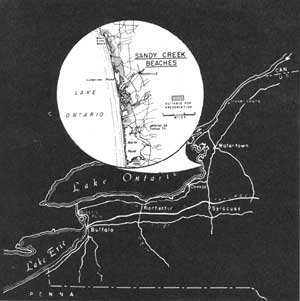
LOCATION This long linear area of beaches and marshes begins about 10 miles north of Port Ontario in Oswego County and continues north almost to Stony Creek in Jefferson County. The area may be reached from a number of access roads feeding off State Highway 3. However, much of the area is accessible only by boat or on foot. The length of the study area from the south end of North Pond to the north boundary is 12.2 miles. Of this, 3.4 miles are excluded because of intensive development, leaving a total of 8.8 miles of shoreline in the study area. Seldom more than a mile deep, the area contains 2,969 acres, mainly marshland.
DESCRIPTION The eastern end of Lake Ontario contains not only the finest beaches on the entire lake, but also the finest wildlife habitat. The study area encompasses the best of both. The main marsh area is four and one-half miles long and one-half to one mile wide. Ponds and open meandering channels are interspersed with the marsh vegetation, and are popular fishing areas. Bird life is abundant both on the marshes and along the sandy beaches. The inland edges of the marshes are generally without development, and border on farmland. Around North Pond, however, cottage development is heavy.
The sand beaches, ranging from 75 to 200 feet in width, are among the finest found anywhere on the Great Lakes, and are backed by a line of wooded, partly stabilized dunes up to 40 feet high. Along practically their entire extent they are bordered by marsh or water areas, a factor hindering cabin developments.
PRESENT USE Aside from the developed areas which have been ringed and excluded from the study area, the principal uses would be hunting, fishing and swimming. Fishing is an important use on all open water areas behind the barrier beach. Only a few, low class structures are found on the barrier beaches. No ownership data was obtained for the Oswego County section, but the rest is all private land with 13 principal owners.
ANALYSIS Important to both migrating and nesting waterfowl and to marsh birds, muskrats and other wildlife, the area is of prime importance for wildlife refuge or game management use. The beaches should be maintained for day use with only the barest essential development for providing access and maintenance. Campers could stay at Stony Point and commute to the beach.

|
| Sandy Creek |
| NEW YORK |
STONY POINT
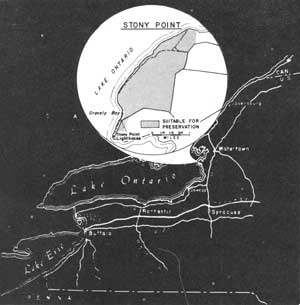
LOCATION Stony Point lies 7 miles west of the town of Henderson in Jefferson County and is accessible by road via State Route 178. The study area comprises approximately 1,600 acres with 3.9 miles of shoreline on Lake Ontario.
DESCRIPTION Stony Point is the southernmost extension of the limestone region of eastern Lake Ontario. It is a region of little marked relief, but forms a series of islands, headlands and bays which add variety to the landscape.
The study area lies in a transition zone between the central and northern forest regions and possesses species characteristic of each. Much of the area was formerly occupied by a U.S. military reservation and considerable land had been cleared, resulting in large meadow areas. In places, these are growing back profusely to white and red cedar. Deciduous woods and boggy depressions occur.
The entire area rests on glacier-scoured limestone which forms scenic cliffs to 60 feet high near the north boundary. Southward they subside to low bluffs and finally to flat, gently shelving beaches of solid rock. Glacier transported boulders on the south end of these rocky shores add geological interest. No sand beaches occur. The alternating patches of meadow and woodland create an edge effect favorable to birds and other wildlife. Many species of songbirds nest in the area and small mammals, such as cottontail and woodchuck, occur. The rich limestone soil grows an abundance of wildflowers.
PRESENT USE Stock grazing is the obvious use at present. The cottage development on Gravely Bay has been excluded from the study area but the lighthouse at the south end has been included. Besides the five acres of lighthouse property, the remainder of the area is divided between three owners.
ANALYSIS The area has considerable charm and would serve well as a natural area. The over-all area is also large enough, and topographically suited, to also supply an abundance of campsites so vitally needed to meet the growing demand in this general region. Such a development could also be utilized in connection with the recommended day-use of the beaches and fishing opportunities at Black Pond and Sandy Creek Beach.

|
| Stony Point |
| NEW YORK |
CROOKED CREEK
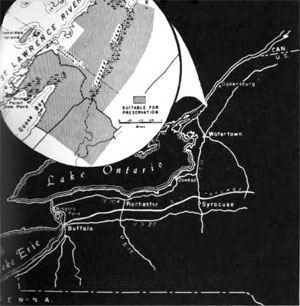
LOCATION Crooked Creek lies adjacent to Kring State Park on the boundary of St. Lawrence and Jefferson Counties. The study area contains 4,425 acres and 4.1 miles of shoreline. Most of the area is accessible only by foot or boat.
DESCRIPTION The Thousand Island region has long been known for its scenic beauty. Here, the St. Lawrence River cuts through an area of glaciated crystalline rocks that forms an isthmus between the ancient Laurentian Highlands of Canada and the Adirondacks of New York. This "granite knob" country, though low in relief, has a jumbled topography that gives the countryside a picturesque appearance. The St. Lawrence flowing through this area creates the Thousand Islands.
The area is in a mixed deciduous-coniferous forest that has been logged or cleared for farming in the past. Boggy areas occur in the hollows, and pink granitic rock is exposed on the prominences. White pine is the prominent shoreline tree. The soil mantle is shallow, and little glacial debris occurs. Spring flowers are abundant and bird life is varied.
The marshes of Crooked Creek and Goose Bay are significant for wildlife: muskrats, waterfowl, shore birds and waders. Ironsides Island, included in the study area, has a large nesting colony of great blue herons. Fishing for bass and perch is popular in the river, and Crooked Creek yields good catches of bullheads.
PRESENT USE Kring State Park, to which Crooked Creek is a recommended addition, occupies a rocky peninsula at the extreme southwest end of the area. This small park is utilized almost completely for camping. Running northeastward for two miles from the park is a strip of shoreline with considerable development; this has been excluded from the study area. Elsewhere, a small commercial fishing dock occurs on Crooked Creek, and a number of cottages have been built along Goose Bay. The bulk of the area is privately owned with about 20 principal owners.
ANALYSIS Because of their high values for camping, wildlife and botanical preservation, Crooked Creek and Ironsides Island should be added to the overused Kring State Park. The inclusion of Ironsides Island would not only assure protection to its large heronry, but give the State of New York title to an entire island in the St. Lawrence for primitive camping.

|
| Crooked Creek (Ironsides Island) |
| <<< Previous | <<< Contents>>> |
rec_area_survey/gl/ny.htm
Last Updated: 27-Jun-2007